
The Black Cat is a 1934 American pre-Code horror film directed by Edgar G. Ulmer and starring Boris Karloff and Béla Lugosi. It was Universal Pictures' biggest box office hit of the year, and was the first of eight films to feature both Karloff and Lugosi. In 1941, Lugosi appeared in a comedy horror mystery film with the same title, which was also named after and ostensibly "suggested by" Edgar Allan Poe's short story.
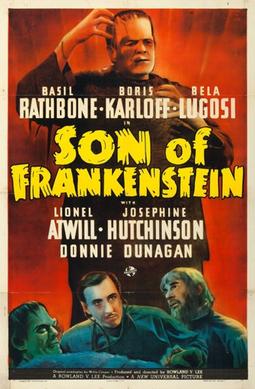
Son of Frankenstein is a 1939 American horror film directed by Rowland V. Lee and starring Basil Rathbone, Boris Karloff and Bela Lugosi. The film is the third in Universal Pictures' Frankenstein series and is the follow-up to the 1935 film Bride of Frankenstein. Son of Frankenstein stars Rathbone as Baron Wolf von Frankenstein who, with his wife Elsa and son Peter, returns to his late father's estate. Near the castle lives Ygor, a crazed blacksmith whose neck was broken in an unsuccessful hanging attempt. Among the castle's remains, Frankenstein discovers the remains of the Monster and decides to try to save his family name by resurrecting the creature to prove his father was correct. He finds, however, the Monster only responds to Ygor's commands.

The Invisible Woman is an American science fiction comedy film directed by A. Edward Sutherland. It is the third film in Universal Pictures' The Invisible Man film series, following The Invisible Man and The Invisible Man Returns, the latter which was released earlier in the year. It was more of a screwball comedy than a horror film like the others in the series. Universal released The Invisible Woman on December 27, 1940.

The Invisible Ray is a 1936 American science-fiction horror film directed by Lambert Hillyer. It stars Boris Karloff as Dr. Janos Rukh, a scientist who comes in contact with a meteorite composed of an element known as "Radium X". After exposure to its rays begins to make him glow in the dark, his touch becomes deadly, and he begins to be slowly driven mad. Alongside Karloff, the film's cast includes Bela Lugosi, Frances Drake, Frank Lawton, Walter Kingsford, Beulah Bondi, Violet Kemble Cooper, and Nydia Westman.
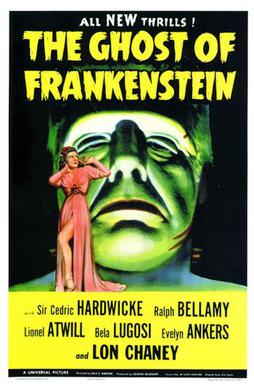
The Ghost of Frankenstein is a 1942 American horror film directed by Erle C. Kenton and starring Cedric Hardwicke, Lon Chaney Jr. and Bela Lugosi. It is the fourth film in the Frankenstein series by Universal Pictures, and the follow-up to Son of Frankenstein (1939). The film's plot follows the previous film's: Frankenstein's Monster and his companion Ygor are chased out of town. They go to another small town to encourage the younger son of Henry Frankenstein to continue his father's experiments, so that Ygor can have revenge against his enemies and his brain transplanted into the Monster's skull.

The Raven is a 1935 American horror film directed by Louis Friedlander and starring Boris Karloff and Béla Lugosi. Billed as having been "suggested by" Edgar Allan Poe's 1845 poem of the same title, excerpts of which are quoted at a few points in the film, it was adapted from an original screenplay by David Boehm. Lugosi stars as a neurosurgeon obsessed with Poe who has a torture chamber in his basement, and Karloff plays an escaped murderer on the run from the police who Lugosi manipulates into doing his dirty work.

Anne Gwynne was an American actress who was known as one of the first scream queens because of her numerous appearances in horror films. Gwynne was also one of the most popular pin-ups of World War II. She is the maternal grandmother of actor Chris Pine.
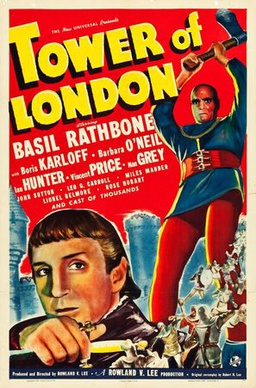
Tower of London is a 1939 black-and-white historical film directed and produced by Rowland V. Lee. It stars Basil Rathbone as the future King Richard III of England, and Boris Karloff as his fictitious club-footed executioner Mord. The film is based on the traditional depiction of Richard rising to become King of England in 1483 by eliminating everyone ahead of him. Each time Richard accomplishes a murder, he removes one figurine from a dollhouse resembling a throneroom. Once he has completed his task, he now needs to defeat the exiled Henry Tudor to retain the throne.
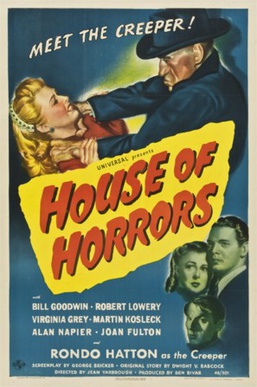
House of Horrors is a 1946 American horror film released by Universal Pictures, starring Rondo Hatton as a madman named "the Creeper".

Universal Classic Monsters is a home video line based on a series of horror films primarily produced by Universal Pictures from the 1930s to the 1950s. Although not initially conceived as a franchise, the enduring popularity and legacy of the films and the characters featured in them has led the studio to market them under the collective brand name of Universal Studios Monsters. Steve Jones of USA Today described Universal's most famous monsters as "pop culture icons", specifically Dracula, Frankenstein, the Mummy, and the Wolf Man.

Sherlock Holmes and the Voice of Terror is a 1942 American mystery thriller film based on Sir Arthur Conan Doyle's Sherlock Holmes detective stories. The film combines elements of Doyle's short story "His Last Bow", to which it is credited as an adaptation, and the real-life activities of Lord Haw-Haw.
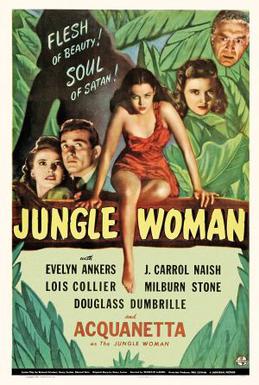
Jungle Woman is a 1944 American horror film directed by Reginald LeBorg. The film stars Evelyn Ankers, J. Carrol Naish, Samuel S. Hinds, Lois Collier, Milburn Stone, and Douglass Dumbrille. The film involves Dr. Carl Fletcher who is in court on the murder of Paula Dupree, who he explains has the ability to turn into an Ape Woman.
Shock Theater is a package of 52 pre-1948 classic horror films from Universal Studios released for television syndication in October 1957 by Screen Gems, the television subsidiary of Columbia Pictures. The Shock Theater package included Dracula, Frankenstein, The Mummy, The Invisible Man and The Wolf Man as well as a few non-horror spy and mystery films. A second package, Son of Shock, was released for television by Screen Gems in 1958, with 20 horror films from both Universal and Columbia.

The Mystery of Marie Roget is a 1942 mystery film starring Patric Knowles. The story was adapted from the short story "The Mystery of Marie Rogêt" written by Edgar Allan Poe in 1842. The film, directed by Phil Rosen and produced by Universal Pictures, is set in 1889.

Horror Island is a 1941 American mystery and horror film directed by George Waggner. It was based on the short story "Terror of the South Seas" by Alex Gottlieb. It stars Dick Foran, Peggy Moran, Leo Carrillo, Eddie Parker, Dale Van Sickle, John Eldredge, Lewis Howard, Hobart Cavanaugh, Iris Adrian and Fuzzy Knight. Foy Van Dolsen plays the monstrous villain "Panama Pete", alias "The Phantom". The plot has assorted colorful characters going to a mysterious island to seek a pirate's hidden fortune.

The Cat Creeps is a 1946 American film directed by Erle C. Kenton and starring Noah Beery, Jr., Lois Collier, and Paul Kelly. It follows a journalist and his photographer who attempt to research an unsolved death and locate a missing fortune, with the help of a black cat that appears to be possessed by the spirit of a dead woman.

The Black Doll is a 1938 American mystery film directed by Otis Garrett and starring Donald Woods and Edgar Kennedy. The film was the second in Universal's Crime Club series following The Westland Case.

Frankenstein is a film series of horror films from Universal Pictures based on the play version by Peggy Webling and the 1818 novel Frankenstein; or, The Modern Prometheus by Mary Shelley. The series follow the story of a monster created by Henry Frankenstein who is made from body parts of corpses and brought back to life. The rest of the series generally follows the monster continuously being revived and eventually focuses on a series of cross overs with other Universal horror film characters such as The Wolf Man. The series consists of the following films: Frankenstein (1931), Bride of Frankenstein (1935), Son of Frankenstein (1939), The Ghost of Frankenstein (1942), Frankenstein Meets the Wolf Man (1943), House of Frankenstein (1944), House of Dracula (1945) and Abbott and Costello Meet Frankenstein (1948).
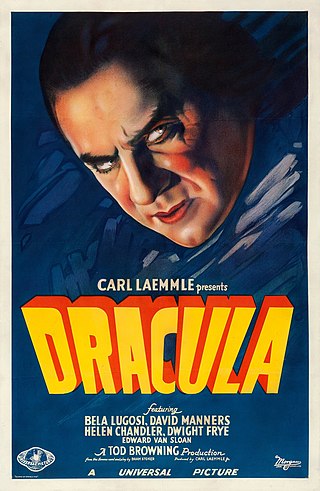
Dracula is a film series of horror films from Universal Pictures based on the 1897 novel Dracula by Bram Stoker and its 1927 play adaptation. The series is a loose collection of films, with historians stating that the films all reference characters, events or at least passing knowledge of the 1931 English-language production of Dracula, with historians noting that Dracula's Daughter and Son of Dracula are more closely related to the 1931 film while the character of Dracula would make smaller appearances in later films such as House of Frankenstein and House of Dracula. After Dracula's Daughter, the character of Dracula and other vampires in the series became more Americanized, starting with the release of Son of Dracula, and the later House of films. The character of Dracula appears in all the films outside of Dracula's Daughter, where he is portrayed by Bela Lugosi, Lon Chaney Jr., and John Carradine in the House of films.
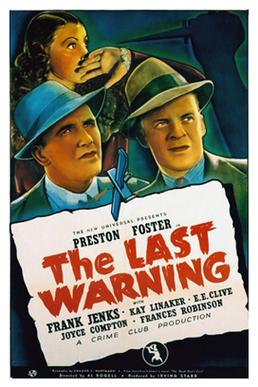
The Last Warning is a 1938 American mystery film directed by Albert S. Rogell and written by Edmund Hartmann. It is based on the 1938 novel The Dead Don't Care by Jonathan Latimer. The film stars Preston Foster, Frank Jenks, Kay Linaker, E. E. Clive, Joyce Compton and Frances Robinson. The film was released on January 6, 1939, by Universal Pictures.



















